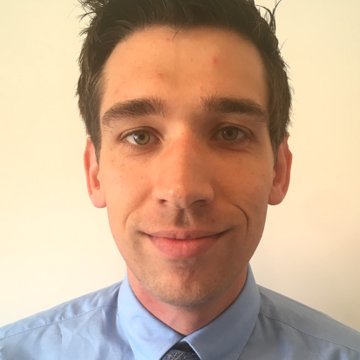Michael Cotterell

Professor Michael Cotterell
Associate Professor in Physical Chemistry
My research concerns laser-based spectroscopy of aerosol particles (mesoscale solid or liquid particles suspended in a gas, with particle diameters ranging from 10 nm to 100 µm) to improve our understanding of their optical, physical, and chemical properties. Applications of our research include: atmospheric aerosols and their impact on Earth’s climate; the potential for accelerated reactions in aerosols; the morphological properties and non-ideal mixing for internally mixed aerosol particles.
Novel Spectroscopic Approaches
We develop sensitive laser-based spectroscopy techniques for the non-contact interrogation of aerosol particles to provide new insights into their physicochemical properties. The interaction of light with a particle is governed by the particle extinction cross section and how it partitions into scattering and absorption components. We develop Cavity Ring-Down Spectroscopy (CRDS) instruments for measurements of aerosol light extinction coefficients, while Photo-Acoustic Spectroscopy (PAS) is our technique-of-choice for accurate measurements of light absorption coefficients.
Excitingly, our group applies these spectroscopic techniques to study single, levitated aerosol particles. We use CRDS to follow the evolving optical properties of single particles levitated in either optical (Bessel-shaped or hollow laser beam) traps, or a linear electrodynamic quadrupole trap. Concurrently, we record the angularly or spectrally resolved elastic light scattering from a further light source, from which the sizes of micron-sized particles are quantified. We also apply these techniques in the laboratory to aerosol ensembles (with ~102-106 particles per cubic centimetre within the spectroscopic probe beam at any instance) with the ensemble having undergone prior particle size selection (using techniques such as electrical mobility or aerodynamic classification). We collaborate closely with the Met Office on projects developing the next generation of instrumentation for in-situ aerosol observations; installed on the FAAM atmospheric research aircraft, these instruments provide accurate measurements of optical properties for aerosols aloft in Earth’s atmosphere.
Photobleaching Kinetics
When light is incident on an aerosol particle, complicated electromagnetic fields develop that may be greatly enhanced in specific regions inside the particle. The role of light in driving chemistry in aerosol droplets is uncertain and has been studied poorly. We are applying our spectroscopy and single particle levitation toolkit to follow the changes in aerosol optical properties for aerosol droplets containing dyes that photobleach when irradiated with UV-visible light. We are unravelling the dependence of photobleaching rates on the particle size, viscosity, and pH for chemical systems important to atmospheric and physical chemistry.
Reaction Acceleration in Microdroplets
Very recent observations have reported accelerated reactions in aerosol droplets, at rates up to a million-fold faster than in macroscopic (beaker-scale) vessels. We are developing a new measurement platform to quantify the rates of formation of chromophores in single, levitated aerosol particles.
Light Absorption and Interfacial Dynamics for Volatile Aerosol Particles
Our research aims to improve our understanding of how the water content of aerosol particles changes their light absorption properties. We are developing new photoacoustic spectroscopy approaches to study aerosol particles that contain volatile species, such as water. From these same photoacoustic measurements, we are studying the mass accommodation coefficient of water (an important quantity that controls the formation of clouds) and the dynamics of molecular adsorption at the gas-particle interface.
Morphology of Dried Particles
We are assessing the impacts of systematic changes in chemical composition for organic-inorganic mixtures on the effective densities and internal structures of dried particles, unravelling the effects of particle viscosity and drying rates on particle shape, structure, and optical properties. These efforts include CRDS and PAS measurements of plumes of dried aerosol particles, characterising their mobility and aerodynamic size distributions, and the collection the particles on filter substrates for electron microscopy assessments of particle shapes and compositional distributions.
Associated Research Themes
Advanced Functional Materials and Interfaces
Energy and Sustainable Chemistry
Michael Cotterell is an Associate Professor in Physical Chemistry and a Tutorial Fellow at Corpus Christi College, Oxford. He studies the physicochemical properties and behaviours of aerosol particles through the development of new laser-based spectroscopy tools. Michael completed his undergraduate degree in Chemical Physics at the University of Bristol (2008-2012), where he remained to complete his PhD (2012-2016) under the supervision of Prof. Jonathan Reid and Prof. Andrew Orr-Ewing FRS. His doctoral work involved the development of Bessel laser beam optical traps to levitate aerosol particles within cavity ring-down spectrometers, for studying the effects of evaporation and hygroscopic water uptake on aerosol optical properties. Michael then conducted postdoctoral research at the University of Exeter (2016-2019) with Prof. Jim Haywood, where he worked closely with Dr Justin Langridge at the Met Office to develop new laser-based spectroscopy instruments for in situ observations of aerosol particles in Earth’s atmosphere. During this time, he secured an Analytical Chemistry Trust Fund Tom West award to support his postdoctoral research. In 2019, he was awarded a NERC Independent Research Fellowship that allowed him to build his own research group at the University at Bristol. He has since secured EPSRC and NERC Standard Grant funding as principal investigator. Michael took up his current joint position between the University of Oxford and Corpus Christi College in September 2023.
Contact
michael.cotterell@chem.ox.ac.uk
College
College webpage: www.ccc.ox.ac.uk/people/professor-michael-cotterell




